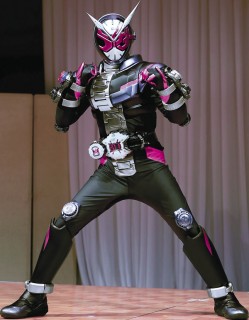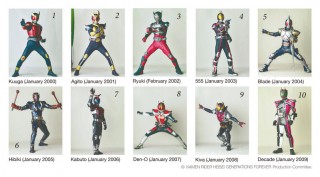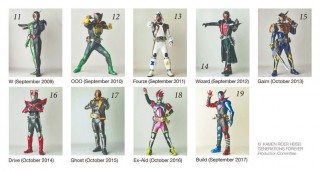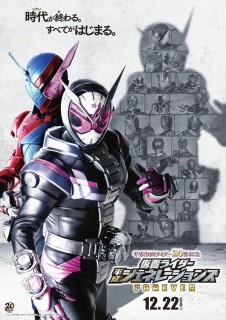Loading
Search
▼ 20 Heisei Kamen Riders
- Category:Other
Inheriting the spirits of heroes created by legendary manga artist Shotaro Ishinomori, the Kamen Rider series made a comeback in the Heisei era, beginning with the debut series “Kamen Rider Kuuga” broadcast in 2000.
Since then, Kamen Rider programs have successfully run for many years, with the series collectively known as “Heisei Kamen Riders.” The latest series, “Kamen Rider Zi-O,” which began airing Sept. 2 on the TV Asahi network, marks the landmark 20th series of Heisei Kamen Rider, and will be the last installation. What mark has Kamen Rider left on this era? This article explores the Heisei era through the lens of Kamen Rider.
Mixed reactions to 1st series “Kuuga”
The debut series, “Kuuga,” is about incidents involving kaijin humanoid monsters in a city in Japan. The series was promoted as a serious show that focused on the characters’ psychology. While “Kuuga” impressed even adults, it attracted criticism for its cruel, violent scenes that stirred fear in audiences. Reaction to the series was mixed, and it tore down norms for tokusatsu hero TV programs.
The second series, “Agito,” featured an ensemble cast of multiple Kamen Riders. “Agito” further developed “Kuuga” while following its pattern and style. However, according to Toei Co. producer Shinichiro Shirakura, the production team prepared to replace Kamen Rider with another tokusatsu TV series after “Agito” concluded, due to a belief that the same series could not enjoy long-term success in the Sunday 8 a.m. slot.
Since then, Kamen Rider programs have successfully run for many years, with the series collectively known as “Heisei Kamen Riders.” The latest series, “Kamen Rider Zi-O,” which began airing Sept. 2 on the TV Asahi network, marks the landmark 20th series of Heisei Kamen Rider, and will be the last installation. What mark has Kamen Rider left on this era? This article explores the Heisei era through the lens of Kamen Rider.
Mixed reactions to 1st series “Kuuga”
The debut series, “Kuuga,” is about incidents involving kaijin humanoid monsters in a city in Japan. The series was promoted as a serious show that focused on the characters’ psychology. While “Kuuga” impressed even adults, it attracted criticism for its cruel, violent scenes that stirred fear in audiences. Reaction to the series was mixed, and it tore down norms for tokusatsu hero TV programs.
The second series, “Agito,” featured an ensemble cast of multiple Kamen Riders. “Agito” further developed “Kuuga” while following its pattern and style. However, according to Toei Co. producer Shinichiro Shirakura, the production team prepared to replace Kamen Rider with another tokusatsu TV series after “Agito” concluded, due to a belief that the same series could not enjoy long-term success in the Sunday 8 a.m. slot.
For the new series, the production team considered a plot in which a pair of heroes wearing masks that resemble Western-style armor fight in a game world. However, the team suddenly changed course and decided to produce a another Kamen Rider series.
In the third series, “Ryuki,” the appearance of the title character greatly differed from previous Kamen Riders as his mask featured eyes behind slits, a stark departure from typical mask designs.
After the decision to produce a third series, the story also totally changed, with 13 Kamen Riders battling each other for survival. Following the Sept. 11, 2001, terrorists attacks in the United States, the theme “What is justice?” was also incorporated into the series.
In the third series, “Ryuki,” the appearance of the title character greatly differed from previous Kamen Riders as his mask featured eyes behind slits, a stark departure from typical mask designs.
After the decision to produce a third series, the story also totally changed, with 13 Kamen Riders battling each other for survival. Following the Sept. 11, 2001, terrorists attacks in the United States, the theme “What is justice?” was also incorporated into the series.
“We strongly recognized the need to maintain the spirit of Kamen Rider, because otherwise the new series would end up simply retaining the ‘Kamen Rider’ name. ‘Ryuki’ marked a turning point,” Shirakura recalled.
Originally, the Kamen Rider series featured stories in which the main characters fought Shocker kaijin monsters who converted the main characters into Kamen Riders. The series incorporated such themes as conflict with one’s family, parricide and self-denial. The world of the Heisei Kamen Riders expanded from that of the original Kamen Rider series and became a long-running series.
The popularity of the Heisei Kamen Riders peaked with the eighth series “Den-O.” Den-O was unique as a Kamen Rider because he rode a train, and old tales were used as a motif. The innovative idea and the series’ cheerful atmosphere helped attract more viewers. Multiple Imagin (kaijin humanoid monsters in “Den-O”) possessed the main character and regularly appeared in the series. The voice actors playing the Imagin characters also drew attention and helped attract anime fans.
“‘Den-O’ marked a turning point in both good and bad ways,” Shirakura said. While the Kamen Rider series differentiated itself from the Super Sentai (superhero) series and was more adult-oriented, “Den-O” attracted more younger viewers.
After “Den-O,” many works featured themes popular with children, such as outer space, wizards, ghosts and games.
Originally, the Kamen Rider series featured stories in which the main characters fought Shocker kaijin monsters who converted the main characters into Kamen Riders. The series incorporated such themes as conflict with one’s family, parricide and self-denial. The world of the Heisei Kamen Riders expanded from that of the original Kamen Rider series and became a long-running series.
The popularity of the Heisei Kamen Riders peaked with the eighth series “Den-O.” Den-O was unique as a Kamen Rider because he rode a train, and old tales were used as a motif. The innovative idea and the series’ cheerful atmosphere helped attract more viewers. Multiple Imagin (kaijin humanoid monsters in “Den-O”) possessed the main character and regularly appeared in the series. The voice actors playing the Imagin characters also drew attention and helped attract anime fans.
“‘Den-O’ marked a turning point in both good and bad ways,” Shirakura said. While the Kamen Rider series differentiated itself from the Super Sentai (superhero) series and was more adult-oriented, “Den-O” attracted more younger viewers.
After “Den-O,” many works featured themes popular with children, such as outer space, wizards, ghosts and games.
Amid these developments, the Kamen Rider series “Gaim” established itself as a well-composed serial drama with serious themes, though it also stood out as unique for basing the designs of Kamen Riders on fruits.
The series was written by Gen Urobuchi, who won acclaim for his anime series “Maho Shojo Madoka Magica” (Puella Magi Madoka Magica).
“Earlier Kamen Rider series received great responses not only when their releases were announced, but also whenever their stories entered new phases,” producer Naomi Takebe said. “We wanted to regain this broad popularity and enthusiasm.”
Kamen Riders from earlier series often served as great inspiration for creators, with “Ryuki” and other works influencing Urobuchi.
Heisei Kamen Riders also influenced various other endeavors.
Since around 2003, tokusatsu heroes produced by other production companies have appeared one after another. However, many were discontinued after two or three works of the same series were broadcast, proving the difficulty of producing tokusatsu programs and underscoring the popularity of Kamen Rider. Meanwhile, local heroes featuring characteristics from certain regions, which began appearing around 2005, are still popular in various parts of the country.
Continuing innovation
Another popular work, “Kamen Rider W,” features a surprising story in which two main characters transform into one Kamen Rider while keeping to the “royal road” of the Kamen Rider series. Last year, the manga series “Futo Tantei” (Futo detective), which depicts the events after “W,” began serialization. Hit productions are still highly influential and lead to many spin-off projects.
Of course, all of the Heisei Kamen Rider series have surprisingly unique features and are supported by enthusiastic fans. It can be said that Heisei Kamen Rider has continued to embrace challenges and generate innovation. “That’s a positive way of putting it. From a negative perspective, however, we don’t know the answer yet,” Shirakura said with a bitter laugh. The renowned producer who oversaw the series tends toward self-denial, which is typical of Kamen Riders.
The series was written by Gen Urobuchi, who won acclaim for his anime series “Maho Shojo Madoka Magica” (Puella Magi Madoka Magica).
“Earlier Kamen Rider series received great responses not only when their releases were announced, but also whenever their stories entered new phases,” producer Naomi Takebe said. “We wanted to regain this broad popularity and enthusiasm.”
Kamen Riders from earlier series often served as great inspiration for creators, with “Ryuki” and other works influencing Urobuchi.
Heisei Kamen Riders also influenced various other endeavors.
Since around 2003, tokusatsu heroes produced by other production companies have appeared one after another. However, many were discontinued after two or three works of the same series were broadcast, proving the difficulty of producing tokusatsu programs and underscoring the popularity of Kamen Rider. Meanwhile, local heroes featuring characteristics from certain regions, which began appearing around 2005, are still popular in various parts of the country.
Continuing innovation
Another popular work, “Kamen Rider W,” features a surprising story in which two main characters transform into one Kamen Rider while keeping to the “royal road” of the Kamen Rider series. Last year, the manga series “Futo Tantei” (Futo detective), which depicts the events after “W,” began serialization. Hit productions are still highly influential and lead to many spin-off projects.
Of course, all of the Heisei Kamen Rider series have surprisingly unique features and are supported by enthusiastic fans. It can be said that Heisei Kamen Rider has continued to embrace challenges and generate innovation. “That’s a positive way of putting it. From a negative perspective, however, we don’t know the answer yet,” Shirakura said with a bitter laugh. The renowned producer who oversaw the series tends toward self-denial, which is typical of Kamen Riders.
Stepping-stone to stardom
The Heisei Kamen Riders featured many actors who later became popular, including Takeru Sato from “Den-O,” Masaki Suda from “W,” Sota Fukushi from “Fourze” and Ryoma Takeuchi from “Drive.”
These popular actors are proof that the TV series continues to be a stepping stone for young actors. In addition to Joe Odagiri and Jun Kaname, who starred in earlier Heisei Kamen Rider series, there are many more actors who appeared in the series, including Hiro Mizushima, Kazuki Kato, Koji Seto and Ryo Yoshizawa.
Like Go Ayano, who played the Orphnoch kaijin humanoid monster in “555,” some actors appeared in the Kamen Rider series only a few times as villains before using their experience to become successful actors. Kenji Urai, who is active as a musical actor, played the human form of Kuuga’s last enemy N-Daguva-Zeba.
The term “ikemen,” a popular expression from the Heisei era that means handsome guy in colloquial Japanese, likely took root because of ikemen Kamen Riders.
The presence of a female perspective in Kamen Rider, namely that of Takebe, helped the series propel the ikemen boom. Events and photo collections featuring “Ryuki” actors also appealed to female fans.
“In the past, some actors avoided tokusatsu TV programs because appearing in such programs created a fixed image, and as a result, they would eventually become unpopular. The times have changed, it’s quite impressive,” Takebe said.
However, it is difficult to find actors well-suited for leading roles. In the case of “Kabuto” and “Den-O,” for example, the production team had to redo auditions from scratch.
“Takeru Sato well understood the aims of the script in which the personality of his character changes, and he performed like he was having fun,” Takebe said. “I remember our relief that we found the best person.”
Secret stories about Heisei Kamen Riders
One of the features of the Heisei Kamen Riders series are the “suit actors” who portray the heros after their transformation. Among them is Seiji Takaiwa, who has appeared in all but two programs of the Heisei Kamen Rider series.
In addition to stunts, Takaiwa is a terrific actor. Kenjiro Ishimaru, who played the owner of Den Liner (a train that carries the protagonist to transit time) in “Kamen Rider Den-O” recalled a scene where Takaiwa expressed the hero’s loneliness with just his back. It brought Ishimaru to tears.
The Heisei Kamen Riders featured many actors who later became popular, including Takeru Sato from “Den-O,” Masaki Suda from “W,” Sota Fukushi from “Fourze” and Ryoma Takeuchi from “Drive.”
These popular actors are proof that the TV series continues to be a stepping stone for young actors. In addition to Joe Odagiri and Jun Kaname, who starred in earlier Heisei Kamen Rider series, there are many more actors who appeared in the series, including Hiro Mizushima, Kazuki Kato, Koji Seto and Ryo Yoshizawa.
Like Go Ayano, who played the Orphnoch kaijin humanoid monster in “555,” some actors appeared in the Kamen Rider series only a few times as villains before using their experience to become successful actors. Kenji Urai, who is active as a musical actor, played the human form of Kuuga’s last enemy N-Daguva-Zeba.
The term “ikemen,” a popular expression from the Heisei era that means handsome guy in colloquial Japanese, likely took root because of ikemen Kamen Riders.
The presence of a female perspective in Kamen Rider, namely that of Takebe, helped the series propel the ikemen boom. Events and photo collections featuring “Ryuki” actors also appealed to female fans.
“In the past, some actors avoided tokusatsu TV programs because appearing in such programs created a fixed image, and as a result, they would eventually become unpopular. The times have changed, it’s quite impressive,” Takebe said.
However, it is difficult to find actors well-suited for leading roles. In the case of “Kabuto” and “Den-O,” for example, the production team had to redo auditions from scratch.
“Takeru Sato well understood the aims of the script in which the personality of his character changes, and he performed like he was having fun,” Takebe said. “I remember our relief that we found the best person.”
Secret stories about Heisei Kamen Riders
One of the features of the Heisei Kamen Riders series are the “suit actors” who portray the heros after their transformation. Among them is Seiji Takaiwa, who has appeared in all but two programs of the Heisei Kamen Rider series.
In addition to stunts, Takaiwa is a terrific actor. Kenjiro Ishimaru, who played the owner of Den Liner (a train that carries the protagonist to transit time) in “Kamen Rider Den-O” recalled a scene where Takaiwa expressed the hero’s loneliness with just his back. It brought Ishimaru to tears.
Battles across time, space
The latest and final Heisei Kamen Rider is a time-traveler who fights across time and space using a watch as a key item. During his journey, the hero meets his predecessors and borrows their power to fight enemies.
The name Zi-O comes from “the king of time,” and “prince.” Z and O in Zi-O also resemble “20.”
Protagonist Sogo Tokiwa was born in the year 2000. It is foretold that 50 years later he will turn into a devil and torment people. People come to the year 2018 from the future, in a bid to prevent Tokiwa from becoming a devil.
On his mask, Zi-O has antenna resembling hour and minute hands, and four katakana characters forming the word “rider.” Another Kamen Rider in the program called Kamen Rider Geiz has four hiragana characters for “rider” on his face.
“We wanted to make Zi-O’s mask something beyond Ex-Aid’s. Ex-Aid had [visible] ‘eye balls,’ and we thought nothing’s more eye-catching than eyes and letters,” TV producer Shinichiro Shirakura said.
Various letters, such as the word “kick” on his foot, are all over the rider suit.
Actor So Okuno, 18, plays 18-year-old protagonist Tokiwa.
“I’ve watched the series up until ‘Kamen Rider Ryuki’ or ‘Kiva,’ and my favorite is Kiva. He’s just so cool,” Okuno said.
Other cast members said things like, “I love Chalice in ‘Kamen Rider Blade,’” “I like ‘Den-O’ because I like the concept of time in the theme,” and “I love ‘Ryuki,’ which has a moving story.”
People who grew up with Heisei Kamen Riders are now performing in the series, bringing its history to a close.
Named from manga?
Does the name Sogo Tokiwa ring a bell? If so, you’re a dedicated manga fan. It’s the name of the new hero who transforms into Zi-O.
“The Story of Shotaro Ishinomori” was aired recently during Nippon TV’s annual 24-hour telethon. The show featured an apartment house named Tokiwa-so, a former residence of many notable mangaka, including Ishinomori.
The drama received comments online such as “That’s how the new Kamen Rider hero got his name!”
The creators of “Zi-O” must have wanted to pay tribute to the creator’s origin for this milestone series.
Reflecting the times
The Heisei Kamen Rider series actively incorporates the trends of different eras into its shows.
The 2011 “Kamen Rider Fourze,” for example, features space, reflecting the popularity of the manga “Uchu Kyodai” (Space Brothers) and the return of the spacecraft Hayabusa from the asteroid Itokawa in the previous year.
“Kamen Rider Gaim” (2013-2014) wore armor and fought with various weapons, surely influenced by the history boom and historical video game “Sengoku Basara.”
“Kamen Rider Den-O” seems to have drawn on the popularity of railways. The voice actors playing Imagin characters became popular, creating an unexpected boom fueled by support from anime fans.
The items that transform heroes into riders also reflect the times.
The hero in “Kamen Rider 555” transforms by entering numbers in a flip mobile phone. An item that looks like a prepaid transportation card was used for Den-O’s transformation, while a USB memory turned a hero into “Kamen Rider W.”
“They symbolized where the future was,” Shirakura said.
Multiple riders are another trend of the recent Kamen Rider series, apparently reflecting the popularity of idol units and groups.
Now on screen
“Kamen Rider Build the Movie: Be the One” and “Kaitou Sentai Lupinranger Vs Keisatsu Sentai Patranger en film” are in theaters, the latest of the Kamen Rider-Super Sentai double features that are an annual summertime attraction for kids.
“Be the One” features a new character who hasn’t appeared on TV. As the series switches from “Kamen Rider Build” to “Kamen Rider Zi-O,” we see the shocking appearance of Zi-O.
A compilation film of all the Kamen Rider series, “Kamen Rider Heisei Generations Forever,” will premiere in theaters on Dec. 22.
Heisei Kamen Riders
Starting with “Kuuga” in January 2000, “Heisei Kamen Riders” is the collective term for tokusatsu hero programs based on the works of Shotaro Ishinomori. Produced by Toei and broadcast by the TV Asahi network, the series aired at 8 a.m. on Sunday after the “Super Sentai” series, with each episode lasting 30 minutes. The two back-to-back tokusatsu programs have attracted many viewers.
From October 2017, Kamen Rider began airing at 9 a.m. Sunday followed by Super Sentai at 9:30 a.m. Each Kamen Rider series lasts a year, except for the 10th series “Decade,” which lasted about seven months in 2009, after which series began in autumn of each year.
The latest and final Heisei Kamen Rider is a time-traveler who fights across time and space using a watch as a key item. During his journey, the hero meets his predecessors and borrows their power to fight enemies.
The name Zi-O comes from “the king of time,” and “prince.” Z and O in Zi-O also resemble “20.”
Protagonist Sogo Tokiwa was born in the year 2000. It is foretold that 50 years later he will turn into a devil and torment people. People come to the year 2018 from the future, in a bid to prevent Tokiwa from becoming a devil.
On his mask, Zi-O has antenna resembling hour and minute hands, and four katakana characters forming the word “rider.” Another Kamen Rider in the program called Kamen Rider Geiz has four hiragana characters for “rider” on his face.
“We wanted to make Zi-O’s mask something beyond Ex-Aid’s. Ex-Aid had [visible] ‘eye balls,’ and we thought nothing’s more eye-catching than eyes and letters,” TV producer Shinichiro Shirakura said.
Various letters, such as the word “kick” on his foot, are all over the rider suit.
Actor So Okuno, 18, plays 18-year-old protagonist Tokiwa.
“I’ve watched the series up until ‘Kamen Rider Ryuki’ or ‘Kiva,’ and my favorite is Kiva. He’s just so cool,” Okuno said.
Other cast members said things like, “I love Chalice in ‘Kamen Rider Blade,’” “I like ‘Den-O’ because I like the concept of time in the theme,” and “I love ‘Ryuki,’ which has a moving story.”
People who grew up with Heisei Kamen Riders are now performing in the series, bringing its history to a close.
Named from manga?
Does the name Sogo Tokiwa ring a bell? If so, you’re a dedicated manga fan. It’s the name of the new hero who transforms into Zi-O.
“The Story of Shotaro Ishinomori” was aired recently during Nippon TV’s annual 24-hour telethon. The show featured an apartment house named Tokiwa-so, a former residence of many notable mangaka, including Ishinomori.
The drama received comments online such as “That’s how the new Kamen Rider hero got his name!”
The creators of “Zi-O” must have wanted to pay tribute to the creator’s origin for this milestone series.
Reflecting the times
The Heisei Kamen Rider series actively incorporates the trends of different eras into its shows.
The 2011 “Kamen Rider Fourze,” for example, features space, reflecting the popularity of the manga “Uchu Kyodai” (Space Brothers) and the return of the spacecraft Hayabusa from the asteroid Itokawa in the previous year.
“Kamen Rider Gaim” (2013-2014) wore armor and fought with various weapons, surely influenced by the history boom and historical video game “Sengoku Basara.”
“Kamen Rider Den-O” seems to have drawn on the popularity of railways. The voice actors playing Imagin characters became popular, creating an unexpected boom fueled by support from anime fans.
The items that transform heroes into riders also reflect the times.
The hero in “Kamen Rider 555” transforms by entering numbers in a flip mobile phone. An item that looks like a prepaid transportation card was used for Den-O’s transformation, while a USB memory turned a hero into “Kamen Rider W.”
“They symbolized where the future was,” Shirakura said.
Multiple riders are another trend of the recent Kamen Rider series, apparently reflecting the popularity of idol units and groups.
Now on screen
“Kamen Rider Build the Movie: Be the One” and “Kaitou Sentai Lupinranger Vs Keisatsu Sentai Patranger en film” are in theaters, the latest of the Kamen Rider-Super Sentai double features that are an annual summertime attraction for kids.
“Be the One” features a new character who hasn’t appeared on TV. As the series switches from “Kamen Rider Build” to “Kamen Rider Zi-O,” we see the shocking appearance of Zi-O.
A compilation film of all the Kamen Rider series, “Kamen Rider Heisei Generations Forever,” will premiere in theaters on Dec. 22.
Heisei Kamen Riders
Starting with “Kuuga” in January 2000, “Heisei Kamen Riders” is the collective term for tokusatsu hero programs based on the works of Shotaro Ishinomori. Produced by Toei and broadcast by the TV Asahi network, the series aired at 8 a.m. on Sunday after the “Super Sentai” series, with each episode lasting 30 minutes. The two back-to-back tokusatsu programs have attracted many viewers.
From October 2017, Kamen Rider began airing at 9 a.m. Sunday followed by Super Sentai at 9:30 a.m. Each Kamen Rider series lasts a year, except for the 10th series “Decade,” which lasted about seven months in 2009, after which series began in autumn of each year.
- September 28, 2018
- Comment (0)
- Trackback(0)





